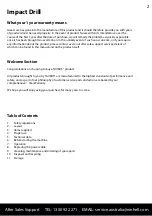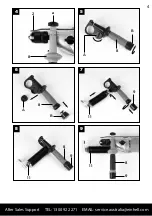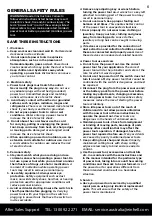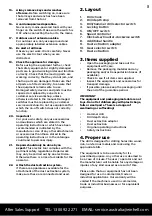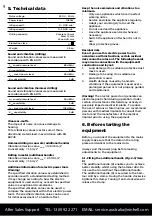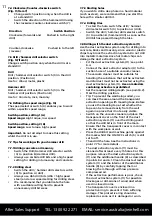
10
After Sales Support TEL: 1300 922 271 EMAIL: service.australia@einhell.com
•
Remove the dust extraction system (11) by
following the above in reverse.
•
Fit the additional handle (8) on the machine
as described in 6.1. Please note that the
additional handle (8) must be fitted to the
left-hand side of the machine if the dust
extraction system (11) is also fitted (Fig. 9).
•
The dust extraction system (11) can be fitted
to the machine even if the additional handle
(8) is fitted.
•
If the dust extraction system (11) is not
required, the cover (A) and the sealing cap
(B) must be fitted to the additional handle
(8).
7. Operation
7.1 ON/OFF switch (Fig. 11/Item 5)
•
First fit a suitable drill bit into the tool (see
6.3).
•
Connect the mains plug to a suitable socket.
•
Position the drill in the position you wish to
drill.
To switch on:
Press the ON/OFF switch (5)
Continuous operation
:
Secure the ON/OFF switch (5) with the locking
button (4).
To switch off:
Press the ON/OFF switch (5) briefly.
7.2 Adjusting the speed (Fig. 11/Item 5)
•
You can infinitely vary the speed whilst
using the tool.
•
Select the speed by applying a greater or
lesser pressure to the ON/OFF switch (5).
•
Select the correct speed: The most suitable
•
speed depends on the workpiece, the type
of use and the drill bit used.
•
Low pressure on the ON/OFF switch (5):
Lower speed (suitable for: small screws and
soft materials)
•
Greater pressure on the ON/OFF switch (5):
•
Higher speed (suitable for large/long screws
and hard materials)
Tip:
Start drilling holes at low speed. Then
increase the speed in stages.
Benefits:
•
The drill bit is easier to control when
starting the hole and will not slide away.
•
You avoid drilling messy holes (for example
in tiles).
•
7.3 Preselecting the speed (Fig. 11/Item 6)
•
The speed setting ring (6) enables you
to define the maximum speed. The ON/
OFF switch (5) can only be pressed to the
defined maximum speed setting.
•
Set the speed using the setting ring (6) on
the ON/OFF switch (5).
•
Do not attempt to make this setting whilst
the drill is in use.
•
The supplied additional handle (8) must
first be fitted. To do this, the clamp must be
opened by turning the handle until it is wide
enough for the additional handle to be slid
over the chuck (1) and on to the hammer
drill.
•
After you have positioned the additional
handle (8), turn it to the most comfortable
working position for you.
•
Now turn the handle in the opposite
direction again until the additional handle
is secure.
•
The additional handle (8) is suitable for both
lefthanded and right-handed users.
6.2 Fitting and adjusting the depth stop (Fig. 4/
Item 2)
•
Undo the thumb screw (a) on the additional
handle (8) and insert the depth stop (2) in
the hole of the additional handle.
•
Set the depth stop and retighten the thumb
screw.
•
Now drill the hole until the depth stop
touches the workpiece.
6.3 Fitting the drill bit (Fig. 10)
•
Always pull the power plug before making
adjustments to the equipment.
•
Release the depth stop as described in 6.2
and push it towards the additional handle.
This provides free access to the chuck (1).
•
This hammer drill is fitted with a keyless
chuck (1).
•
Open the chuck (1). The drill bit opening
must be large enough to fit the drill bit into.
•
Select a suitable drill bit. Push the drill bit as
far as possible into the chuck opening.
•
Close the chuck (1). Check that the drill bit is
secure in the chuck (1).
•
Check at regular intervals that the drill bit or
tool is secure (pull the mains plug).
6.4 Fitting the dust extraction system (Fig. 5-9)
•
The dust extraction system (11) is fitted on
the additional handle (8). It can also be used
in combination with the depth stop (2). This
prevents the work area becoming very dirty.
•
Release the cover (A) and the sealing cap
(B) by turning the additional handle (8).
Several drill bits can be stored in the sealing
cap (B) to save space (Fig. 5-6).
•
Screw the dust extractor adapter (9) on to
the additional handle (8) from underneath.
•
Now place the dust extraction system (11)
on to the additional handle (8) as shown in
Fig. 7 – 8 and secure it by turning it.
•
Important. There are detents on the
cover (A) and the dust extraction system
(11) which must be engaged in the
corresponding recesses on the additional
handle (8) before the cover (A) or dust
extraction system (11) can be turned and
locked.


